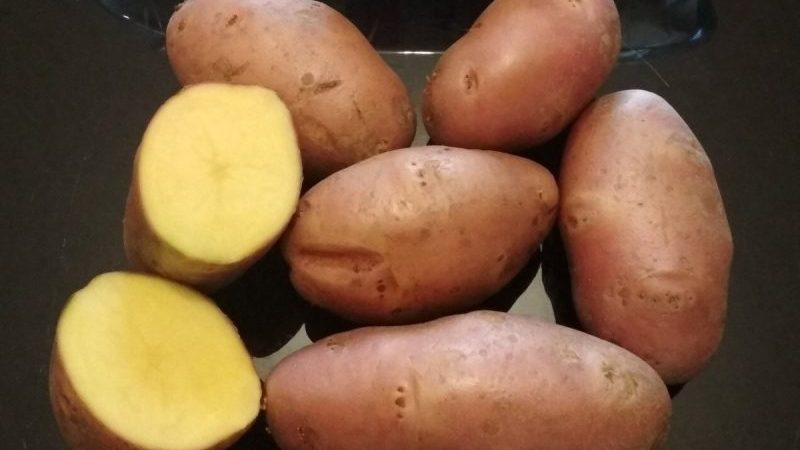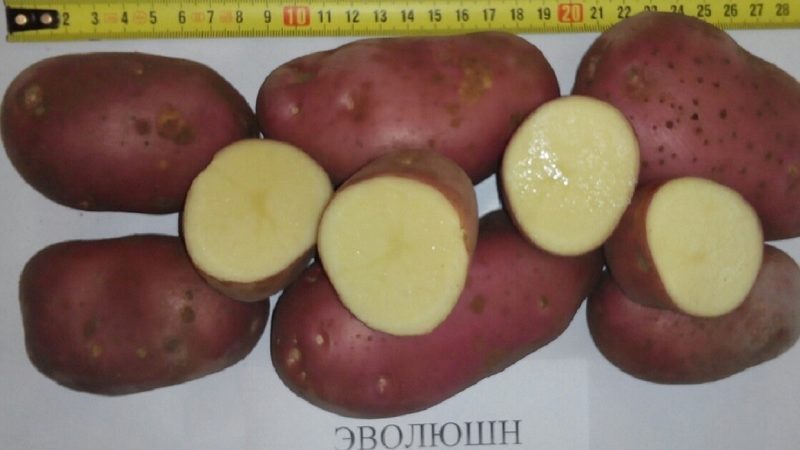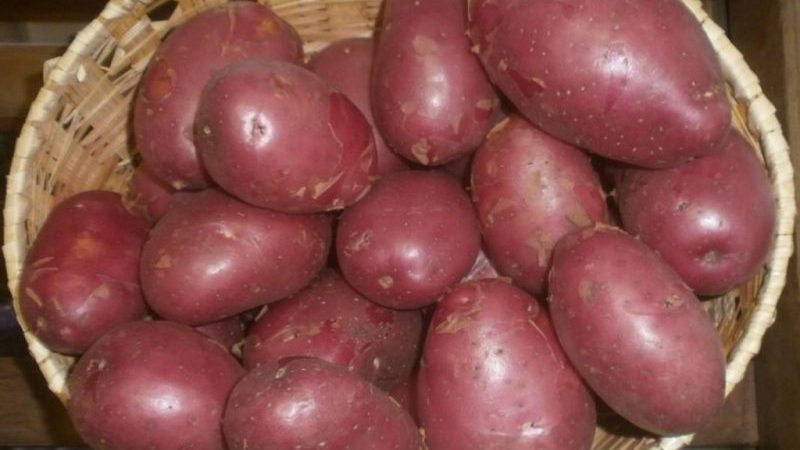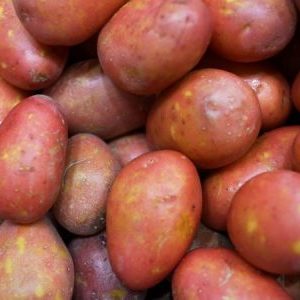High-yielding potato variety "Evolution", able to adapt to the conditions of any climate
Evolution potatoes in a short time fell in love with many gardeners. It grows in almost all regions, regardless of climatic conditions, ripens quickly and gives a good harvest. For cultivation, standard agricultural techniques are sufficient.
Consider the description of the Evolution potato variety with a photo and the method of growing it.
The content of the article
Description of the variety
Potatoes Evolution medium early, table purpose. It is grown for sale or for yourself. The variety is unpretentious, high-yielding, resistant to many diseases culture.
Origin and development
The Dutch variety was launched in 2011 by Agrico U. A. It quickly fell in love with summer residents around the world, and a year later it hit the Russian market. In 2015, it was entered into the State Register of the Russian Federation.

Composition
The main indicator for potatoes is starch. In the tubers of this variety, its content is moderate, 11-16%.
Vitamins and minerals in the pulp:
- C, E, B1, B2, PP;
- sodium, potassium, calcium, magnesium, phosphorus, iron.
Their number depends on the region of growing potatoes and the applied fertilizers.
Ripening period and yield
Evolution fully matures on days 65–85. The exact time depends on the region and the weather.
Important! Adequate watering, adequate fertilization, weed control and loosening ensure a rich potato crop.
The yield is high - 240-420 kg / ha. The maximum indicator (548 c / ha) was obtained in the Vologda Oblast.
Disease and pest resistance
Potatoes are resistant to golden cyst nematode, cancer, wrinkled mosaic. Moderately susceptible to late blight, which at high humidity affects the tops and tubers.
Specifications
The tubers are the same in shape and weight. The average weight of a vegetable is 80–150 g. The shape is oval with small eyes. The peel is reddish. The pulp is light yellow, it does not boil during cooking. The taste is rich and pleasant.
Evolution is a versatile variety in use... It is suitable for preparing salads, soups, frying.
Growing regions
The culture bears fruit well in almost any area. Recommended for the North-West, Central, Volga-Vyatka, North Caucasian, Ural, West Siberian regions of Russia. It grows best in temperate climates.
Advantages and disadvantages

The variety is unpretentious in care and versatile in cooking. Main advantages:
- high productivity;
- pleasant taste of tubers;
- good keeping quality (up to 95%);
- moderate starch content in the pulp;
- persistent immunity to major diseases.
Disadvantages:
- potatoes are difficult to tolerate drought and lack of moisture;
- the seed material degenerates, so it is changed every 2-3 years;
- inflorescences quickly fall off.
Differences from other varieties
Many varieties of potatoes are not versatile in cooking due to the fact that the tubers fall apart when frying. In contrast to them, Evolution potatoes retain the structure of the pulp, they are even fried in deep fat.
The variety tolerates many diseases well, is resistant to low temperatures.
Features of planting and growing
The cultivation of Evolution potatoes is in many ways standard, but it has some nuances.
Training
Before landing remove all weeds and residues of last year's plants, since they can slow down the growth of potatoes. The earth is carefully dug up together with complex fertilizers from phosphorus, magnesium and potassium.
Tubers are chosen smooth, without damage and rot. From infections they are treated with fungicides.
Ground requirements
The soil is chosen with a slight alkaline index. Too acidic soil will adversely affect the development of the root system and further reduce yields.
The variety is especially fond of loose sandy soils.
Landing time and scheme
Ground temperature suitable for planting is not lower than + 8 ° C at a depth of 10 cm.
Interesting! Some are guided by popular belief: when the first leaves appear on a birch, the potatoes are ready to be planted in the ground.
It makes no sense to insulate the soil: the air will cool the ground, and potatoes will not rise under the covering materials.
In the European part of Russia, the variety is planted in early May, in the northern part - in mid-May, in the south - starting from April 15.
The landing pattern is standard:
- the distance between the rows is from 60 to 75 cm;
- the distance between the bushes in a row is 30–35 cm;
- planting depth of tubers - 7-8 cm.
Immediately after planting, the culture is watered.
Growing features

It is important to huddle the rows in time so that the root system does not become exposed. Weeds are removed regularly and the soil is loosened so that the plants receive adequate oxygen, moisture and nutrients.
Proper watering is one of the most important factors in obtaining a quality crop. In temperate climates, potatoes are rarely moistened, once a week. In the south or in consistently hot weather - when the soil becomes dry.
For the first time after planting, the bushes are watered after 20 days, as soon as young shoots appear. The second irrigation is carried out before the beginning of flowering, the last - after the fall of the inflorescences.
Important! When tubers form, watering is stopped so that dampness does not provoke the appearance of late blight.
If, when planting potatoes, the soil was fertilized with organic matter or complex mineral agents, the subsequent feeding do not conduct. Wood ash is scattered between the rows against Colorado potato beetle. If the soil has not been fertilized, when growing a crop, they use droppings, manure, humus. Make sure that there is no excess nitrogen, otherwise all the forces of plants will be directed to the growth of green mass, and not tubers.
As soon as weeds appear in the garden, they are immediately removed. This is especially important before the flowering of the variety. The soil is loosened after irrigation or rain.
The potatoes are spud twice for the entire time: after the bushes reach 20 cm in height and after 2-3 weeks. Additional mulching of the beds with hay or dry grass slows down the growth of weeds and retains moisture in the soil.
Disease and pest control
Evolution is resistant to most potato diseases, but its tops are susceptible to late blight. Therefore, the seed material is treated with fungicides before planting and the irrigation regime is observed.
The solution of "Fitosporin-M" is sprayed on the bushes in the evening in dry, cool weather.
Important! Leaves are processed a few days before watering.
Of the pests for potatoes, the Colorado potato beetle is the most dangerous. They use "Inta-Vir" or "Aktara" against him. The first drug is effective, but the beetles quickly get used to it. The second tool fights pests well, but beneficial insects also suffer from it. Therefore, chemicals are not used near apiaries.
Poisonous baits or ultrasonic repellents are used against mice.
Growing difficulties
When cultivating the Evolution variety, it is important to properly water the soil. With drought or waterlogging, the tubers begin to deteriorate and stop developing.
So that pests do not spoil the harvest, the culture is treated with special preparations and preventive measures are taken.
Harvesting and storage
Harvesting begins when the potatoes are fully ripe. They are guided by the following signs:
- the tops began to dry and lie down a third of the height;
- the peel on the tubers is thickened and withstands mechanical damage;
- the growing season has expired.
On day 85, the potatoes are considered fully ripe.
The tubers are dug up with a shovel or pitchfork and then harvested by hand. Not only ripe potatoes are extracted from the ground, but also last year's so that it does not feed the pests.
The crop is placed for 3 days in a dark dry room for drying and debris from the ground, then sorted out. Remove all damaged potatoes. Temperature for long-term storage of vegetables - + 3 ... + 5 ° C, humidity - 85–90%. If these conditions are met, the potatoes lie throughout the winter.
Reviews
Evolution is in demand among vegetable growers. Some of them share useful tips, others - their impressions.
Natalia, Pavlovo: «In spring, when growing the variety, fresh manure or nitrogen fertilizers cannot be applied. The manure may contain weed seeds not processed by the animal's body. Nitrogen causes the growth of tops, not tubers. "
Anna, Mr. Marks: "It is better to stop watering at least 3 weeks before harvesting Evolution, otherwise the potatoes will get sick with late blight. "
Ekaterina, Zelenogradsk: “The taste of potato pulp Evolution - 9 out of 10. The tubers are huge compared to the varieties I have grown before. The family really liked it! "
Conclusion
Evolution potatoes are suitable even for novice farmers. He is unpretentious in care, has a strong immunity to golden nematode, crayfish, wrinkled mosaic. Subject to the watering regime, the variety will not get sick with late blight. The quality and excellent taste make potatoes versatile in cooking.